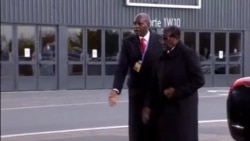As more than 190-countries gather in Paris, France, to try and save the planet from adverse weather conditions caused in part by human actions, Zimbabwe and South Africa are grappling with effects of climate change, such as El Nino, which have wreaked havoc on weather patterns, resulting in severe drought.
The southern African countries are looking to the 21st Conference of Parties (COP21) for urgent solutions to reverse the serious and unpredictable impacts of climate change on the world's water systems.
The COP21 summit in Paris comes at a time when the effects of global warming are threatening both human and plant life in Zimbabwe, South Africa and other southern African countries where silting river beds and dying livestock are the order of the day, albeit in the middle of a rainy season.
A combination of drought and heat waves has hit these two countries as a result of El Nino-inspired weather pattern, marked by warming sea-surface temperatures in the Pacific Ocean, causing extremes such as scorching weather in the region.
The El Nino phenomenon occurs every few years, affecting sub-Saharan Africa with droughts mainly and floods here and there.
As a result of El Nino’s impact, indications are that South Africa is quickly running out of water and a number of its provinces have been declared disasters areas.
Attesting to this, Francois Engelbrecht, Researcher at the South African-based Council for Scientific and Industrial Research (CSIR), says the current effects of climate change as seen in South Africa and other southern African countries is worrisome, and should encourage those meeting in France to do more in addressing climate change.
Engelbrecht says, “In fact 2015 is on the way to be the warmest year ever recorded by humans. We have seen temperature records being broken this year and El Nino events are also usually associated with below normal rainfall during our mid-summer period that is still to come, that is the period December to February.”
South Africa’s Minister of Water and Environmental Affairs, Edna Molewa, says her government is fully aware of the impact and is doing its part to fight global warming. She says she is positive COP21 will help countries to pull towards the same direction.
“Government’s response is taking many forms and those many forms include setting up policy framework, which we have done. In this case we have a climate response policy that’s solid in place and then we also look at issues of research. We continue to research the medium to long-term climate impact and adaptation response options.”
The impact of the climate change has not gone unnoticed to many of the region’s citizens.
Zimbabwean national, Ngqabutho Mabhena, chairman of the Zimbabwe Community in South Africa says the El Nino effects have been devastating.
“You now have massive drought, running short of drinking water, lack of rainfall. We have run out of grazing land for the animals. Animals are dying in numbers. These are all effects of climate change in Zimbabwe.”
Mabhena is urging the COP21 Paris summit to compel countries to adhere to their commitment to limit emissions as is being called by climate activists, so as to keep global warming within two-degrees Celsius as agreed in 2010.
Rise in temperatures is partly pinned on human activity such as burning fossil fuels, industrial agriculture and the carbon produced by melting permafrost which experts say are producing greenhouse gases.
The World Bank warns that if emissions are not reduced, this could double natural disasters to an extent that 100 million more people could be thrown into deep poverty by 2030.
Maxwell Hadebe, an unemployed South African national and resident of Soweto, too is concerned about the impact of climate change, and predicts a dark and gloom future if COP21 does not come up with urgent measures for countries like his.
“It has affected us very much. There is no doubt on that one because the way we feel now I think we have no hope. Unless something else comes up, our people will definitely die.”
According to scientists, carbon dioxide levels should remain below 350 parts per million (ppm) to be considered safe. However, this number is currently about to hit the 400 ppm mark at a growth of 2-ppm per year.
The World Meteorological Organization (WMO) has found a 36-percent increase in the greenhouse gas emissions in the last 25 years and attributes the rise to industrialization. This gloomy picture has led to climate change that has resulted in more extreme weather conditions such as heat waves and floods.
Many are now pinning their hopes on the COP21 summit in Paris to come up with strict measures that will force countries to reduce greenhouse gas emissions.
















